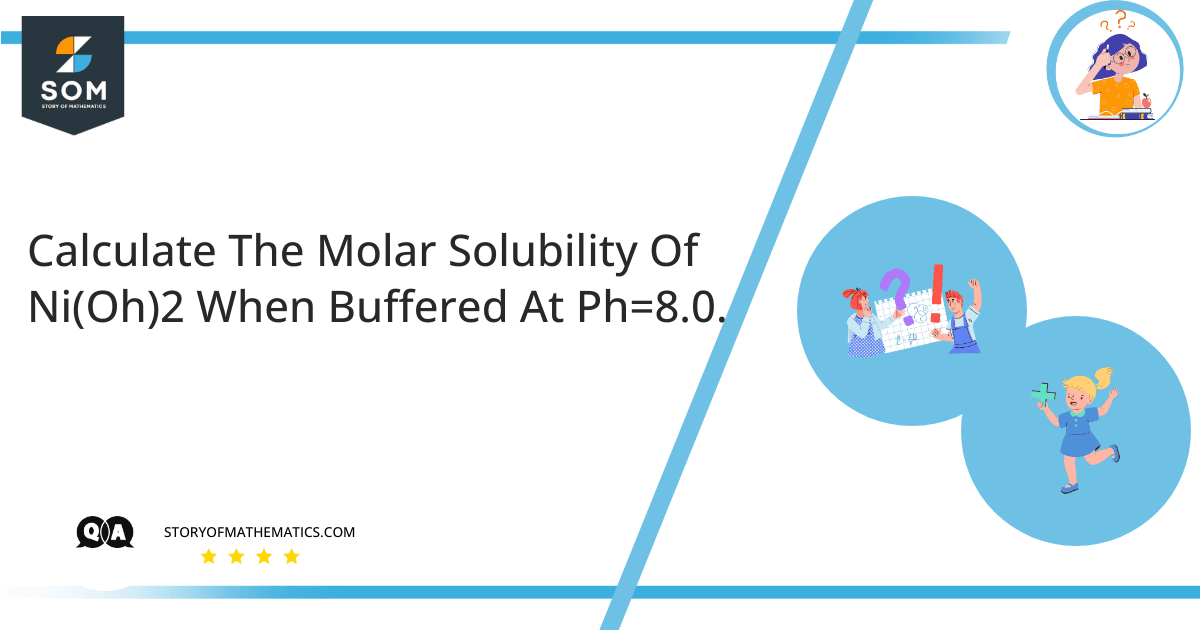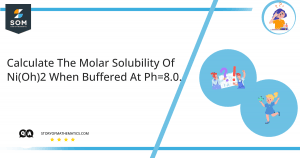
This question aims to find the molar solubility of Ni(OH)_2 when buffered at ph=8.0. The pH of a solution determines whether a solution is basic or acidic. pH is measured by a pH scale which ranges from 0-14.

A solution giving a pH reading of 7 is considered neutral, whereas a solution giving a pH greater than 7 is considered a basic solution. Similarly, a solution having a pH less than 7 is considered an acidic solution. Water has a pH of 7.
Expert Answer
A higher concentration of hydronium ions is present in the acidic solution with fewer concentrations of hydroxide ions. On the other hand, basic solutions have higher concentrations of hydroxide ions and traces of hydronium ions.
Hydronium ions and hydroxide ions have equal concentrations in pure water. The concentrations of hydronium and hydroxide ions are equal to:
\[1.0 \times 10^{-7} M\]
The given pH is $8$. it means the solution is basic as pH value exceeds $7$. We will therefore consider pOH. To find pOH, we will use the formula:
\[pOH = 14 – pH\]
\[pOH = 14 – 8\]
\[pOH = 6\]
The pOH of an aqueous solution can be determined by:
\[pOH = -log [ OH^{-1}]\]
The pOH value is used as a subscript for $[ OH^{-1}]$
\[[ OH^{-1}] = 1.0\times 10^{-6} M\]
$Ni(OH)_2$ will break down into $Ni^{2+}$ and $2OH^{-1}$
The chemical reaction is given as:
\[Ni (OH)_2 \rightleftarrows Ni^{2+} (aq) + 2OH^{-1} (aq)\]
A buffer solution is a type of solution containing a conjugate base and weak acid. We will use the solubility constant to find the value of the molar solubility. The solubility constant is represented by $K_s{p}$, and the formula is:
\[K_s{p} = [A^+]^a [B^-]^b\]
Where:
\[[A^+]^a = [Ni^{2}]\]
\[[B^-]^b = [2OH^{-1}]\]
Numerical Solution
By putting values in the formula:
\[K_s{p} = [Ni^{2+}] [2OH^{-1}]^2\]
The given value of $k_s{p}$ is $6.0$ x $10^{-16}$ $g/L$
The molar solubility of $[Ni^{2+}]$ is $6.0$ \times $10^{-4}$ $M$
Example
Find solubility product constant Ksp of calcium fluoride $(CaF_2)$, given that its molar solubility is $2.14 \times 10^{-4}$ moles per liter.
The dissolution of $CaF_2$ gives the following products:
\[CaF_2 (s) =Ca^{+2} (aq) + 2F^{-1} (aq)\]
Putting value in $K_s{p}$ expression gives the following results:
\[K_s{p} = [Ca^{+2} ][ F^{-1}]^2 \]
$Ca^{+2}$ and $CaF_2$ has a molar ratio of $1:1$ whereas $CaF_2$ and $F^{-1}$ has a molar ratio of $1:2$. The dissolution of $2.14 \times 10^{-4}$ will produce twice the amount of moles per liter of $F^{-1}$ in the solution.
By putting the values in the $K_s{p}$ , we will get:
\[K_s{p} = (2.14 \times 10^-{4}) (4.28 \times 10^-{4})\]
\[K_s{p} = 3.92 \times 10^-{11}\]
Image/Mathematical drawings are created in Geogebra
